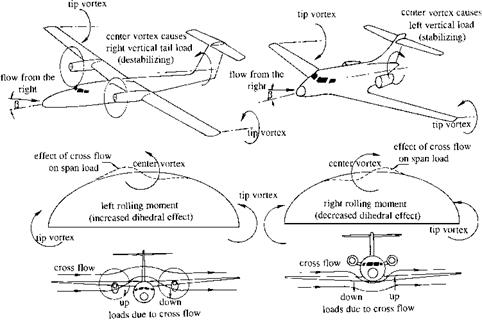Wing-Body Interference
The longitudinal, lateral, and directional stability of wings and bodies in combination are the isolated characteristics plus effects that reflect modification of the flow by interference. In the longitudinal case, upwash ahead of the wing and downwash behind the wing change the body local angles of attack that enter into the Munk momentum theory calculations. Munk’s apparent mass theory for bodies was extended by Hans Multhopp (1941) to account for the nonconstant fuselage angle of attack due to the wing’s flow field. Gilruth and White (1941) used strip theory for this modification.
Stability and control designers have known for some time that whether an airplane has a high or a low wing influences static directional and lateral stabilities. There was an organized study of this at NACA starting in 1939 as a part of a broader attack on the factors influencing directional and lateral stability. The wing position part of the study was completed in 1941 by House and Wallace.
Distortion of the wing’s spanwise lift distribution and trailing vortex system due to sideslip has the following systematic effects:
Low wing airplanes: Static lateral stability is reduced by about 5 degrees of equivalent wing dihedral as compared with mid-wing airplanes. This rule of thumb has lasted to the present day. Static directional or weathervane stability is increased.
High wing airplanes: The reverse of the low wing case. Dihedral effect is increased by about 5 degrees, weathervane stability is decreased.
Cross-Flow Concept The cross-flow concept aids in understanding aerodynamic forces for an airplane in sideslip. The total velocity vector VEL of an airplane in sideslip can be resolved into a component U along the X or longitudinal body axis and a component V along the Y or lateral body axis. The U component gives rise to a symmetric flow, while the V component gives rise to a hypothetical flow at right angles, along the Y body axis. The component flows add together to make up the total streamline pattern of the airplane in sideslip.
The V or cross-flow component is represented in Figure 6.2. This figure provides an explanation for the effects of high and low wing positions on stability. The effects are the result of the distortion of a wing’s span load distribution in sideslip. Undistorted wing span load distributions feature sharp gradients of load with spanwise distance at both wing tips.
|
Figure 6.2 Cross-flow explanation of wing vertical position effects on directional stability and dihedral effect. Distortion of the wing span load in right sideslip creates a center vortex that gives destabilizing sidewash for a high wing and stabilizing sidewash for a low wing. The distorted span load gives increased dihedral effect for a high wing and decreased dihedral effect for a low wing. |
Local shed vortex strength is proportional to this gradient, resulting in the familiar wing tip vortices. The flow of air from higher to lower pressure determines the sense of vortex rotation. Thus wing tip vortices rotate to create downflow, or downwash, inboard of the wing tip.
The center vortices shown in Figure 6.2 are the result of the local span load distortion due to wing-fuselage interference in sideslip. Center vortex rotations for low and high wing arrangements in sideslip are seen to be consistent with the observed stability changes noted above.












